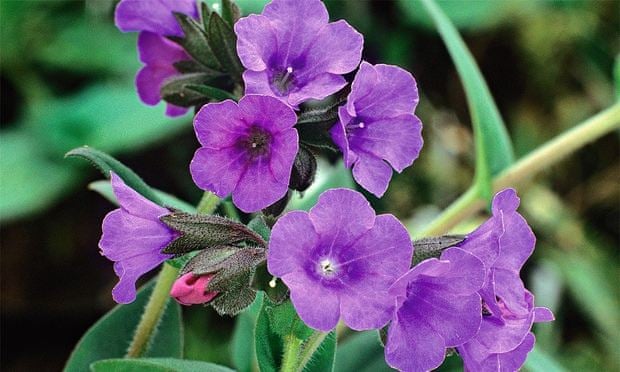
The bees are on the wing from spring to early summer, by which point they build a single nest, laying their eggs in excavations, mud banks and soft mortar in walls. They are incredibly gentle: you’d have to squeeze one tight to get it to sting.
Any opportunity to please such a wonderful bee should be embraced. The obvious choice is to plant pulmonaria. P. ‘Blue Ensign’ with its tropical ocean-blue flowers borne about dark green foliage doesn’t mind shade, so will happily sit under shrubs as long as the soil stays moist. ‘Trevi Fountain’ is as good a blue; the leaves are flecked with silver spots and it flowers for as long as it can. Or if a more refined white is your thing, ‘Sissinghurst White’ is one of the first pulmonarias to flower, starting in March and ending in April. Red lungwort (P. rubra) is more coral pink than red; it repeat flowers into early summer. P. rubra, P. ‘Blue Ensign’ and ‘Trevi Fountain’ look lovely planted with the Japanese painted fern Athyrium niponicum var pictum ‘Ursula’s Red’, which has reddish-bronze growth.
I also have a fondness for comfreys, though only if you have space to let them roam, as they are rather rambunctious. I use dwarf comfrey (Symphytum ibericum) under my fruit trees. It has rusted-red flower buds that open to white flowers. These appear before a new flush of leaves (it’s not evergreen in very cold spots). It is easy enough to keep under control; just hack away at it. The spoils can be rotted down to feed plants.
S. azureum is invasive, but lovely. It has grey-blue green leaves and pale azure flowers, and will run away with your garden if you let it. S. tuberosum is much easier to control and has soft lemon yellow flowers. Like dwarf comfrey, it doesn’t mind shade or poor soil.
If you buy any of these plants now, while in flower, water regularly until you see new signs of growth. And make sure they are pesticide-free, otherwise it’s not much of a treat for the bees.